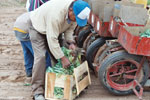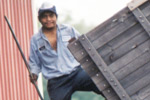Packing
Orchard Packing Facts: Can be divided into manual and semi-automatic process. Manual packing is mainly for delicate varieties, to meet client requests, or in smaller packing houses. Apples are sorted, packed, and then segregated.
Major components:
Sorting:
- Severely damaged and rotten fruit is removed.
- Cleaning and waxing occurs after the initial sorting by grade.
Packing:
- Workers may do both manual and semi-automated packing.
- Forklifts transport bins to the packing line.
Manual packing:
- Worker retrieves the apple using one hand, transfer the apple to another hand, and then place it into waiting paper trays or bags.
- Workers may be paid hourly (conveyor speeds sets the work rate) or piece-rate (set by the automated filling of the receiving bins).
- Standard apple box holds 5-6 trays and can weigh 40-50 pounds.
Semi-automated packing:
- Indented paper trays are fed into the packing conveyor where the apples are delivered from the computer controlled sizer.
- Packers manually adjust each apple for optimal presentation.
- The pace is determined by the speed of the conveyor.
- Filled trays are manually placed in boxes located at the end of each packing conveyor.
- Repacking: This occurs for changes in production needs, to meet client requirements, etc. Repacking is not performed at a standard packing station and usually done manually by an experience packer.
Segregating:
- Segregators (usually male workers) manually lift the boxes from the conveyor and place them on wooden pallets according to labeled size and grade.
- Some packing houses use an automatic palletized.
- Forklifts transfer the pallets to the loading dock or to storage.
- Musculoskeletal Risks in Washington State Apple Packing Companies (Synder, Flanagan, Camp et al 2001).
 Muscle Strain
Muscle Strain
 Slips, Trips & Falls
Slips, Trips & Falls